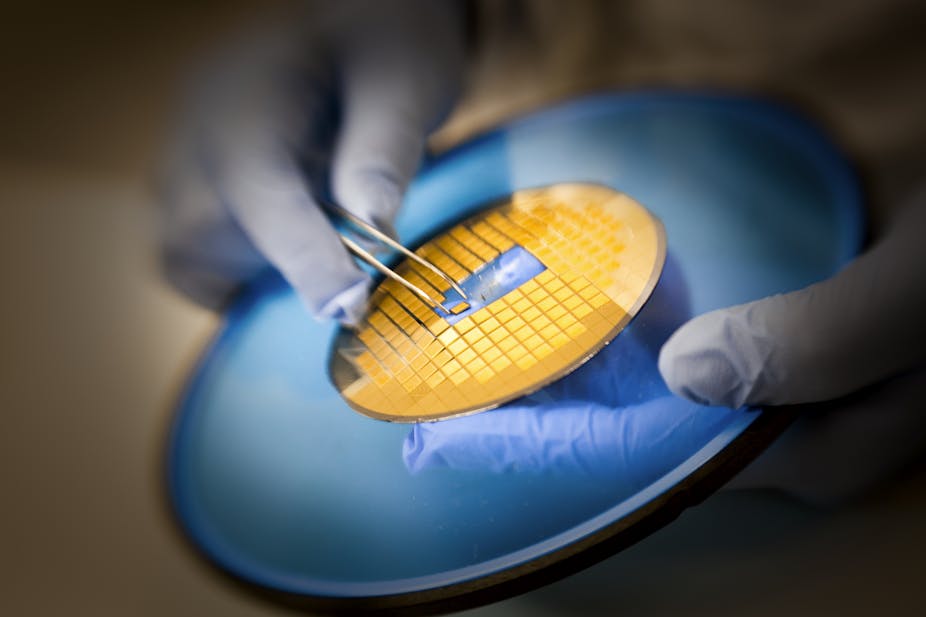A couple of facts:
1) At least 10% of the world’s population are “needle phobic”, which means they’re missing out on being vaccinated and/or have a horror of receiving jabs of any kind. Several studies suggest this figure may be closer to 20%
2) More than 90% of vaccines are injected, via needles and syringes, into our muscles. Although on many levels this is a successful way of delivering vaccines (i.e. a great number of diseases have been eradicated) it’s also rather inefficient because it misses the body’s immune “sweet spot”.
I believe the Nanopatch, which I invented, could offer a very effective solution to these issues, and several others. It targets vaccines, with a 100th of the dose currently required, to immune sweet spots in the skin, achieving equivalent protection to the needle and syringe.
And because it’s just a patch, applied for less than two minutes, it removes the need for needles.
What is it?
The Nanopatch looks like a square, standard patch (see above), but has thousands of tiny little projections that are invisible to the human eye.
The length of these projections is typically around 100 micrometers or so, but the tips of the projections can be down often to the nanoscale, about 100 nanometers or so. Many of the vaccines, delivered by the patch, are made up of components around 50 nanometres in diameter.
At present it has been proven on mice, and the next stage is human clinical trials.
How it works
When we apply the patch to the skin, the projections on its surface breach the tough outer layer and enter a very wet environment within the skin, where the live cells are located.
In this environment, the vaccine dissolves very quickly and is uptaken by antigen-presenting cells. These cells, with the signal of the vaccine on their surface, move to the lymph nodes. Here they pass the signal on to T cells, which pass through the lymph node at a very high volume and speed.
It also passes the signals on to B cells as well, so there is a concert of T and B cells. In this way you move from a local delivery to an overall body immune response.
It’s only in recent times that the international community realised the skin offers so much potential for vaccines, and so now there’s a catch-up in terms of technologies to exploit that.
Potential benefits
There will be several benefits, I believe, to the kind of technology we’re developing, such as:
1) Because the vaccine the patch uses is in dry form, we get around the need for vaccine refrigeration, which is a far bigger problem than people realise.
Half the vaccines in Africa are thought not to work properly due to a breakdown in the “cold chain”, the process used to maintain optimal conditions during the transport, storage, and handling of vaccines.
2) It’s expected to be a pain-free approach: the sensation of having the patch attached to your arm will be equivalent to that of any patch being applied to your skin. This will, I’m sure, be very attractive to parents and children alike.
3) Improved immunogenicity provided by the patch (i.e. its ability to produce an immune response) could mean fewer visits to the doctor. We will be able to bundle more vaccines together, and there’s the potential for fewer boosters.
4) The fact there’s no need for refrigeration, coupled with the simplicity of the application, removes the need for a trained practitioner.
We believe the Nanopatch could ultimately be posted out to people for self-application in the event of a pandemic.
A serious contender
Our team at the University of Queensland is leading the world in this technology at the moment. We’ve formed a company called Vaxxas and are at the latter stages of securing multimillion dollar investment.
This would give our company the teeth it needs to prove the Nanopatch works on humans, and to develop a device that’s both scaleable and suitable for widespread use.
Assuming the trials are successful, what we’re working on now could change the game entirely.
Would you choose the Nanopatch over the needle? Why?/Why not? Leave your comments below.

